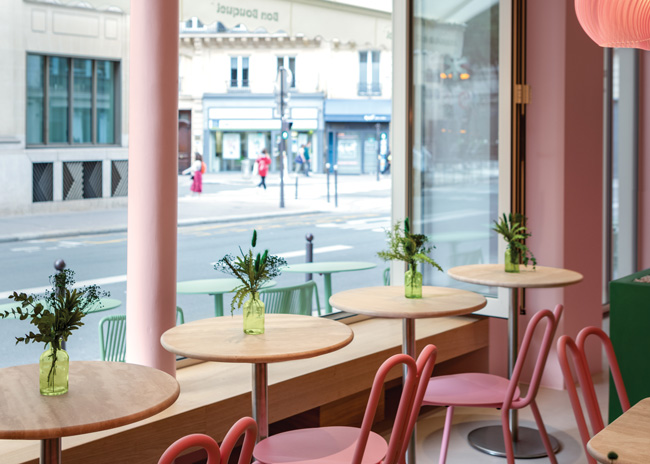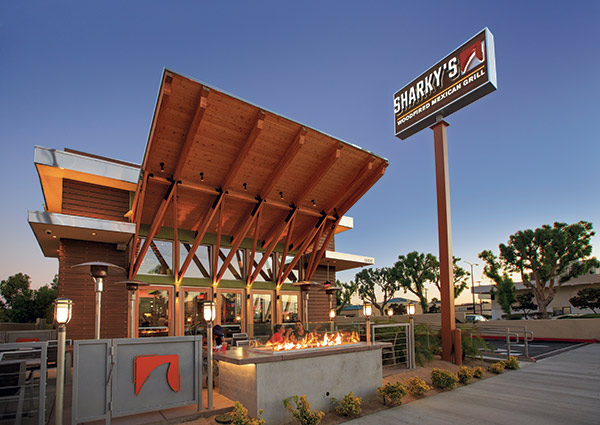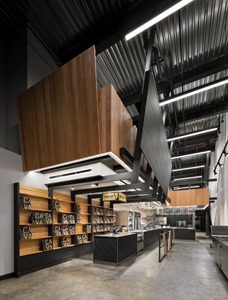 HapstakDemetriou+ clients such as CAVA, a fast-growing Mediterranean fast casual, are gleaning customer preference and traffic flow insights via sophisticated data analysis, ultimately impacting design decisions. Image courtesy of Michael MoranThe bar on quality is rising fast and so are project costs. Technology, social media and next-gen designers are changing the game at every level. Consumer expectations continue to evolve. And it’s no longer good enough to simply design functional, great-looking restaurants: Today, it’s all about creating experiences.
HapstakDemetriou+ clients such as CAVA, a fast-growing Mediterranean fast casual, are gleaning customer preference and traffic flow insights via sophisticated data analysis, ultimately impacting design decisions. Image courtesy of Michael MoranThe bar on quality is rising fast and so are project costs. Technology, social media and next-gen designers are changing the game at every level. Consumer expectations continue to evolve. And it’s no longer good enough to simply design functional, great-looking restaurants: Today, it’s all about creating experiences.
So say this year’s Designers Dish panelists, an esteemed group of designers and architects whose firms are noted for creating great-looking restaurants and exciting experiences for independent and chain concepts nationwide. Read on for insights and inspiration from Peter Hapstak of HapstakDemetriou+, Cass Calder Smith of CCS Architecture, Elizabeth Plecha of Aria Group Architects, and John Paul Valverde and Miguel Vicens of Coevál Studio. They even offer some free advice and a few concept ideas of their own.
What are two big-picture trends or forces you see driving restaurant design today?
Hapstak: Shorter consumer attention spans and rising costs. Something’s really hot and then it’s not, so clients are very concerned about longevity. We’re constantly getting the question, “How is this going to feel in 5 to 10 years?” If something is too cute or whimsical, it fades badly, so one trend is just trying to keep concepts and designs more timeless. A related driver right now is just the whole issue of rising costs. It’s getting so astronomical to build anything and so many projects are underfunded, especially start-ups. Clients are often completely surprised at how much it costs to try to get done what they want to get done, so we spend a lot of time educating them. So, there’s this timelessness and longevity that everyone’s striving for but a lack of understanding of what it costs to achieve it.
Calder Smith: Cost is a huge issue right now. It isn’t really about aesthetics, but the trend toward lower-priced concepts with less risk and lower opening costs is still going strong. From a design perspective, that typically means a more casual look and feel; compact, hyper-functional spaces; and strong branding to carry the concept over multiple units. The other, more general thing is that the bar for restaurants just keeps being raised. It’s an intensely competitive and tough business. Costs are higher all the way around, but so is scrutiny from sophisticated, social-media-savvy consumers. Ultimately, it’s all good, though, because it makes us do really good work.
Plecha: We continue to see the need to maximize seating and create flexible spaces that can accommodate large parties and events. We’re seeing more concepts popping up that aren’t even run as restaurants, per se, but solely as event spaces. And even in traditional restaurants, flexible seating and integrated wall panel systems that can section spaces off are becoming more important. We’re also seeing a big move toward furniture pieces and case goods that are more stylized and with more of a residential feeling. Clients are tired of seeing the same old restaurant chairs and tables and spaces. They’re looking for something a little more custom, more unique to their space and their concept. For us, that means a lot of research up front to find or design unique items that are readily available and/or fit into their budget.
Valverde: Everyone is now sharing their experiences through Instagram, Snapchat, etc. How that all plays out can have a tremendous impact on a client’s business, and it impacts how we need to think about design. We’re no longer designing just for environmental interaction but for social media interaction as well. The second big trend is that clients want to get more out of their spaces by creating multiple concepts or experiences in a single location. They’re paying rent every day, all day, so it makes sense. For example, they might have a coffee shop/cafe operating in front from 7 a.m. to 5 p.m., and then a bar component in the back that operates from 9 p.m. to 2 a.m. It’s a plus for real estate developers, too, because you’re knocking out two concepts in one.
What impact is technology having on your restaurant projects today?
Plecha: This falls into major trend territory as well, but there’s a huge uptick in mobile order apps at QSR and fast-casual restaurants, and as a result, we’re beginning to design more mobile order pickup areas. We’re always thinking about how customers will travel through a space, but that’s now changing. Some still come in and order and eat on-site, but a growing number place orders online or via mobile app and just stop in to pick up their food and go. So it’s thinking about how to organize the adjacencies and where everything belongs, how big the pickup area needs to be and how it should be organized to serve all guests well. Also, USB ports for mobile charging have become a necessity. We use a lot of outlet/USB port strips that run along the entire underside of a countertop, for example, so that no matter where you’re sitting, you can plug in. And we’re hiding outlets in booths, banquettes and even chairs. I imagine we’ll be switching to charging pads in tabletops and countertops soon. We’re also incorporating new cooking technologies, such as grills that don’t require hoods or black iron. People love to see their food being prepared, and that whole show of the kitchen is important. Ventless equipment helps us bring it up front and out from under the hood.
Hapstak: The whole mobile app phenomenon is definitely huge. We’re watching clients develop these very sophisticated apps enabling customers to just walk in, pick up their orders and go. For one client, we’re now working on what’s going to be known as a “fly through,” and it’s where everyone in the QSR category is headed. You order on an app ahead of time, pull up to a designated window and pick up your food. We also see clients getting very sophisticated with data — pulling all manner of customer preference, traffic and flow information. CAVA, a Mediterranean fast casual that we work with, is leading the way on this, and what the data is telling them directly impacts how we design their spaces, with grab-and-go from mobile ordering getting bigger and bigger. The big brands, like Domino’s, are all over this, too, but we’re waiting to see the development of better solutions for brands that don’t have the resources or technical sophistication of a Domino’s or CAVA.
Valverde: With trends heading so sharply toward mobile orders and delivery, we need to make sure that our layouts and designs enable clients to compete. Even if it’s a 5 percent or 10 percent increase in their daily sell, that’s huge for a restaurant. We had a client that is one of the biggest Uber Eats clients in the city. When designing a new unit for them, they had us dedicate a full area for drivers to park and drive up to a window to pick up orders for delivery because that’s become such a big part of their business.
Calder Smith: Acoustics and LED lighting are among the biggest areas of technology-driven change. LEDs are just getting better and better, with greater control and color rendition. And sometimes it’s about bringing different technologies, such as solar panels, into a project. I think most nice, full-service restaurants are still a ways away from implementing many customer-facing technologies. They’re efficient, but as they’re packaged and presented today, they kind of kill the experience.
Where do you see the biggest improvements and/or opportunities for concept or design innovation in the chain restaurant segment?
Hapstak: We’re trying to steer clients away from the fast-casual buffet-line-style prototype and toward a more holistic way of thinking about their concepts. You can only do so many point-and-pick order lines, and you can use as many cast-iron pots and stainless hotel pans as you want, but at a certain point, you lose the soul of it. So we’re pushing a lot of ideas about what a real kitchen feels like because we think that’s what customers warm up to. What’s that experience? How does it work, and how does it feel? We’re also urging clients to think bigger and consider ways to leverage their concepts and facilities. Can they sell their own mustard or hot sauce or maybe their bread? They have all this equipment sitting there, and they put a lot of money into making their places look awesome — they should make them work as hard as they can.
Calder Smith: Everyone who’s designing in this new fast-casual world is looking at full-service restaurants as competitive inspiration, not at other QSRs or fast casuals. We just did a redesign for fresh&co. They have 15 or so units around New York City and were beginning to see sales slipping to other brands that offer a more enhanced experience. They realized the fact that experience-driven design now really matters to consumers, whether they’re in a full-service restaurant or a fast casual. We did a lot of research and analysis and ended up creating a design with elements such as residential-style finishes and varied seating, including tall community tables, regular tables with banquettes and lounge areas. We used a lot of brick and wood flooring — the same types of finishes you’d see in a nice full-service restaurant.
Vicens: We’re definitely beginning to see restaurant chain directors looking for better building and restaurant designs. They’re reaching out to studios that design experiences versus just buildings or traditional architecture because they no longer want to feel like a fast-food place or a large, corporate kind of restaurant.
Valverde: And that’s great because ultimately the consumer wins. They get a better experience because they’re at a restaurant that they actually enjoy versus just going there because it’s quick and convenient. I’d also say that there are a lot of opportunities for concept innovation, especially to develop new ethnic chain options beyond Chinese and Mexican. We’re working on some ethnic concepts, such as Indian, that are fun and inviting and offer cocktails and great ambience.
Plecha: We see chains picking up trends in independent restaurant design, too, but there’s typically a lag time of about 12 to 24 months. Most corporate chain structures aren’t as nimble and can’t move quickly to implement design changes due to multiple store locations, adaptability of branding and chain of command in decision making. But that’s where they’re heading. We also see chains using a lot more natural materials, such as stone and wood, in their designs and streamlining beverage and condiment areas for a more designed aesthetic. And we’re moving toward more innovative solutions for displaying food along the front line. In a project we did recently for Roti, a Mediterranean fast-casual brand, the food display is tilted up to give customers a better visual of the ingredients than in the standard fast-casual line, where they don’t see the food until they get to the counter and then have to look down into the line to make their choices.
What’s different about next-gen designers entering the industry, and how might those differences impact restaurant design in the future?
Vicens: There’s so much young talent out there, and this new generation of designers doesn’t necessarily come in thinking, “I’m going to go to work for these people and learn from their experience.” A lot of times, they come in thinking they want to do something different, to push new design directions that are much more experience-driven than in the past. That can be a very positive and exciting thing for the industry and for consumers. And current and future young designers just learn so much faster than we did thanks to technology and everything that opens up to them.
Valverde: Right. Whereas we started drawing in CAD, which is 2-D, for example, now a lot of young designers are starting to design in 3-D from the get-go. Instead of seeing it on a piece of paper, you’re seeing it in a different perspective, in a different dimension. It’s affecting the industry in a positive way because the faster we get to 3-D, the faster we can get the client to experience it in virtual reality and the better results we get, which ultimately gives the consumer a better experience. So it’s a trickle down.
Plecha: Next-gen designers are focused on creating unique experiences and sharing them with others. We’re not just creating a place for people to eat a meal; we’re creating an experience that begs to be shared on social media with Instagrammable moments. If you think about Millennials in general, they have very high expectations for any type of experience. In restaurants, they expect everything to be on point — food, design and atmosphere — so there’s a lot of pressure to get all of those things right.
Calder Smith: You’ve always had architects, interior designers and a few firms like ours that do both. But we all were pretty traditionally trained. As architects, we know how to solve complicated problems, how to get as many seats as possible in a space, how to get the kitchen in the right place, etc., but the traditional focus wasn’t creating experiences. A lot of the young people coming in now aren’t architects; they’re thinkers and experience creators, but sometimes they run into trouble because they don’t think about things like building permits. We sometimes feel like the parental supervisors. But it’s kind of cool, too. They’re working as designers, and who knows what they might have a degree in? They might be from the fashion world and be very well traveled and astute at incorporating experiences in to spaces. I find us competing against them and going, “Whoa, these guys are different.” I guess when I was young, I was more like that, too, but now I’m tainted by practicality.
Hapstak: It stuns me how much more intuitive they are with technology, and they really look for ways that technology can transition into physical space. We have a guy, for instance, who’ll just grab our simple models and on his own quickly take them to VR. All of a sudden, we have a walk-through. It seems to just come naturally. Another cool thing is that they don’t feel like they have to have hundreds of thousands of dollars to create good solutions. They have different ways of seeing things, but like any next gen, they need experience. If they’ve never done the detail work and actually built something, their ideas aren’t going to become reality. It’s a balance, but they bring new energy and incredible talent to work and are why I still have such fun getting up and coming to work every day.
Is technology changing the way you do business?
Calder Smith: For us, it’s really just about keeping up with the latest, greatest software – 3-D modeling and rendering, etc. Everything still is communicated through drawings, and clients are used to seeing that. If you’re a design studio, your work needs to look like it came from a design studio and not an engineering office. We’re also toying a bit with virtual reality. It’s pretty neat, and I know it’s happening more and more, but it’s not yet a big part of what we do.
Valverde: We use technology that we call Virtual Experience. Basically, it helps us inform and have the client experience their spaces before they’re actually built. It helps a lot with confirming scale and dimensions — the right ceiling heights or size of the bar, for example. We can put them in that virtual experience, have music playing that they might potentially play in their bar, have the bar top that they’d be sitting at, etc. So with the goggles on, they really experience what the space would be. And we’re continuing to add more details to it. The other day, we were in it, sitting down at a table, and I had a glass in my hand. You actually feel like you’re inside the space. When you’re investing so much money into these projects, these kinds of technologies used on the front end help us minimize changes requested during building because the client has such a good feel for what it will actually be.
Vicens: As designers, we’re driven to design experiences, but not all clients understand drawings or photos. We can show them a picture of how this is going to be, but it’s ultimately not really accurate. So we push it a bit more and incorporate the virtual reality experience so they can actually feel the ceiling height, the height of the lamp and those kinds of elements in their space. It leaves clients with a better understanding of what they’re actually getting and lets us collaborate and make changes in real time.
Hapstak: We basically operate our office on ARCHICAD and take it into BIMx, which allows us to put on a headset and go virtually into the space. It’s not that new, but it’s pretty amazing because we can sit with clients in real scale models, make changes in real time and show them their space from lots of angles. When you’re doing restaurants and hospitality, such a high level of detail goes into these models, and it’s so helpful for them to be able to see it and know exactly what they’re getting.
Plecha: For larger projects, we’ll build 3-D models and do photorealistic renderings. It’s cool because you can create these walk-throughs of a space, and they can really start to visualize what it’s going to be like and become more comfortable with trusting us to actually build it for them. But it depends a lot on budget, too, because using those technologies is more time-consuming and adds to the cost. On smaller projects, we typically show everything visually with AutoCAD and Photoshop renderings with colors on the floor plan, the reflective ceiling plan and a series of elevations, which we find really helps to portray what the space is going to feel like as well. So there are a lot of technologies that can help us be artistic and communicate effectively with clients of all sizes.
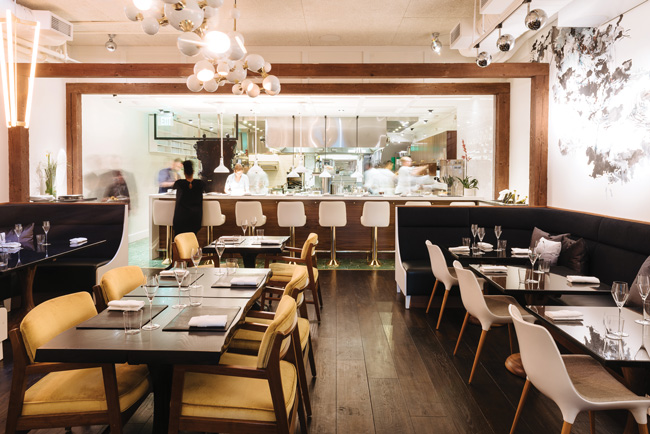 Pineapple and Pearls in Washington, D.C. Image courtesy of Kate Warren/GoKateShoot
Pineapple and Pearls in Washington, D.C. Image courtesy of Kate Warren/GoKateShoot
Peter Hapstak, Founding Partner
HapstakDemetriou+, Washington, D.C.
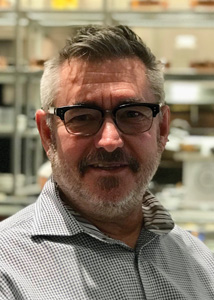 Advice to clients: There’s no rush to the altar. Take the time to build a relationship with your designer and understand where the project is going before setting the GC loose. Check references. Trust us to do what you hired us to do. You get what you pay for.
Advice to clients: There’s no rush to the altar. Take the time to build a relationship with your designer and understand where the project is going before setting the GC loose. Check references. Trust us to do what you hired us to do. You get what you pay for.
Top-of-mind materials: Simpler, basic materials used in fresh, updated ways. We’re on the hunt right now for the perfect plywood, something we can use as a finish material.
If I opened my own restaurant: It would probably be a neighborhood brasserie bistro with an American flair. The menu would lean toward healthy but be comfortable and accessible — no precious food or crazy microchemistry.
Who would you choose to design it? Ilse Crawford, a London-based designer who has very clever ways of looking at traditional things. She keeps things timeless yet fresh, rich yet humble.
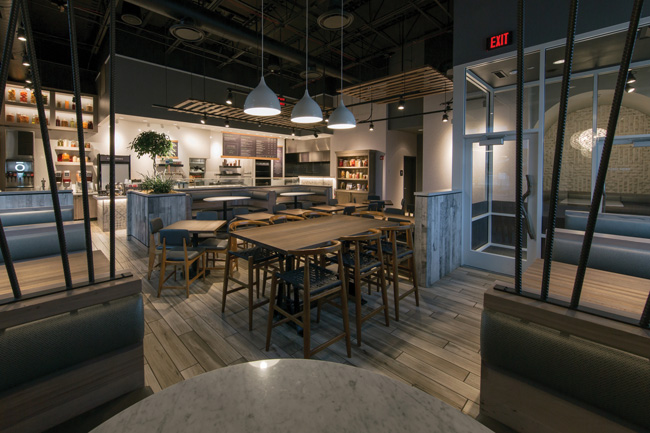 QSR and fast-casual chains such as Roti are using more natural materials in their designs. Image courtesy of Emilia Czader
QSR and fast-casual chains such as Roti are using more natural materials in their designs. Image courtesy of Emilia Czader
Elizabeth Plecha, Senior Interior Designer
Aria Group Architects, Inc., Oak Park, Ill.
 Advice to clients: Be up-front about your budget. It’s far more efficient to create a design for an appropriate budget than to value engineer a design after the fact. Understand the design and documentation phases of a project, and be aware of the inefficiencies and extra design cost implications of making changes after prior approvals.
Advice to clients: Be up-front about your budget. It’s far more efficient to create a design for an appropriate budget than to value engineer a design after the fact. Understand the design and documentation phases of a project, and be aware of the inefficiencies and extra design cost implications of making changes after prior approvals.
One big challenge: Everyone wants chairs and stools that are unique, comfortable, affordable, durable and readily available. It’s rare that we’re able to hit all five of those wants on any given project.
Top-of-mind materials: I’m currently obsessed with decorative acoustical panels and LED rope lighting.
If I opened my own restaurant: I’d create a very Zen sushi restaurant for 20 guests, max, with plenty of seats at the counter.
Who would you choose to design it? Yuko Kagawa. I love her design of Kai Zan restaurant in Chicago.
.jpg) Covina, located inside the Park South Hotel in New York City. Image courtesy of CCS.
Covina, located inside the Park South Hotel in New York City. Image courtesy of CCS.
Cass Calder Smith, Founding Principal
CCS Architecture, San Francisco and New York
 Advice to clients: Allow enough time. Working in emergency mode isn’t good for projects. Embrace collaboration. Designers aren’t just a cost; we bring tangible value to your project. Don’t just hire a good designer; find the right one for your concept.
Advice to clients: Allow enough time. Working in emergency mode isn’t good for projects. Embrace collaboration. Designers aren’t just a cost; we bring tangible value to your project. Don’t just hire a good designer; find the right one for your concept.
One big challenge: Clients want bespoke furnishings, but most manufacturers are too production-oriented to be willing or able to do that at a reasonable cost.
Top-of-mind materials: LED lighting and faux finishes. Some of the faux finishes, like porcelain tile that looks like wood, are now so realistic. They’re less expensive, super durable and never need refinishing. It’s hard to say no to that stuff.
If I opened my own restaurant: It would be something with seafood and have a casual, Northern California vibe with a residential feel. I especially love clams…and avocados. Maybe it would be an avocado clam bar.
Who would you choose to design it? Le Corbusier is my favorite architect, but I’m not sure he’d design a cool restaurant. Maybe Richard Neutra, an Austrian-American architect who lived in L.A. and did beautiful midcentury-modern homes.
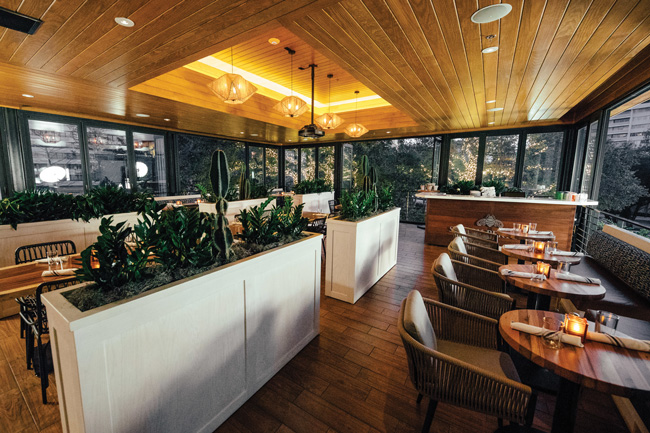 An enclosed patio installed within surrounding treetops at Jalisco Norte in Dallas. Image courtesy of Kathy Tran
An enclosed patio installed within surrounding treetops at Jalisco Norte in Dallas. Image courtesy of Kathy Tran
John Paul Valverde (l.) & Miguel Vicens, Co-Creative Directors
Coevál Studio, Dallas
-&-miguel-(right).jpg) Advice to clients: Think strategically and keep development and design focused on the clientele you want to sell to. You hired an experienced team to help, so keep an open mind, listen and let them.
Advice to clients: Think strategically and keep development and design focused on the clientele you want to sell to. You hired an experienced team to help, so keep an open mind, listen and let them.
Top-of-mind materials: Wall coverings. We’re seeing a lot of beautiful, durable wallpapers that can really change the look of a room. Also metals, which are economical, versatile and create unique looks.
Materials wish list: More products that are suitable for renovation projects, i.e., that can be used without having to first reface entire floors or walls. Better, more beautiful lighting options for commercial clients who don’t have huge budgets.
If I opened my own restaurant: I’d do an airy, approachable sushi place with a good cocktail program. —Valverde
I’d just focus on something that appeals to the masses, nothing too niche. But I’d never do it because it takes all of your time. —Vicens
Who would you choose to design it? I’d hire a team from Ukraine. I follow several Ukrainian designers, and they do a lot with a little to create very raw spaces that are also warm and inviting. — Valverde
My background is architecture, so I’d probably pick someone like Zaha Hadid or Renzo Piano because of their attention to detail. —Vicens


